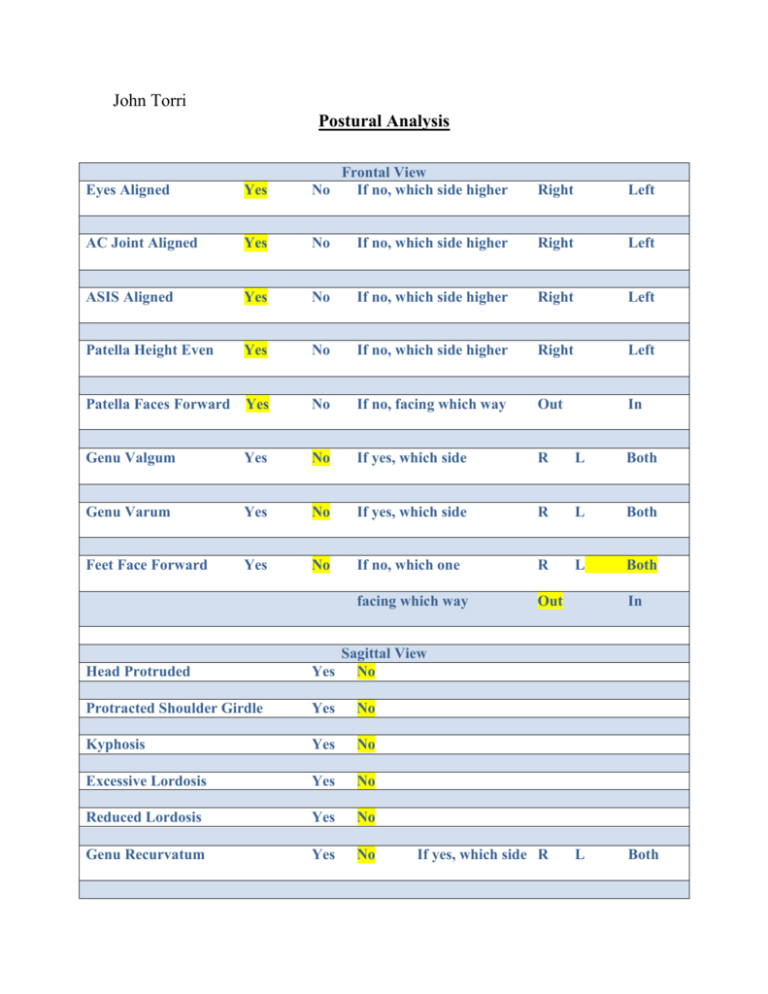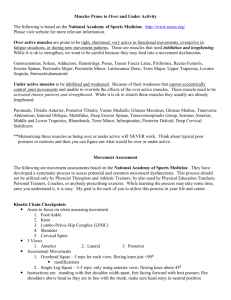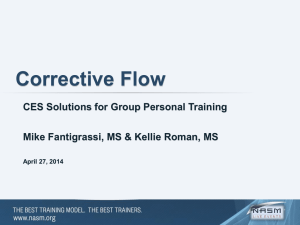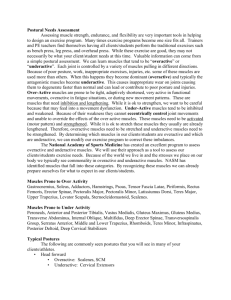Posterior View
advertisement

John Torri Postural Analysis Eyes Aligned Yes No Frontal View If no, which side higher Right Left AC Joint Aligned Yes No If no, which side higher Right Left ASIS Aligned Yes No If no, which side higher Right Left Patella Height Even Yes No If no, which side higher Right Left Patella Faces Forward Yes No If no, facing which way Out In Genu Valgum Yes No If yes, which side R L Both Genu Varum Yes No If yes, which side R L Both Feet Face Forward Yes No If no, which one R L Both facing which way Out In Sagittal View No Head Protruded Yes Protracted Shoulder Girdle Yes No Kyphosis Yes No Excessive Lordosis Yes No Reduced Lordosis Yes No Genu Recurvatum Yes No If yes, which side R L Both Winged Scapula Yes Posterior View No If yes, which side Feet Evert Yes No If yes, which foot R L Both Feet Invert Yes No If yes, which foot R L Both R L Both From these three views I can determine nothing of a serious concern when analyses my posture. In Neutral position the eyes are aligned, as well as my AC joint. Only a few things stood out to me in my analysis, in the anterior view you can notice that my feet are slightly facing outwards. This may be because of possible overactive muscles such as soleus, lateral gastrocnemius, TFL as well as Biceps Femoris. Some Underactive muscles that contribute to my posture could be Medial Gluteus, Medial Gastrocnemius, Medial hamstrings, Gracillis/ Sartorius, and even the Popliteus. As for my Back posture, based on these images I can see no issues. However in my squat assessment I will take a closer look into possible issues Overhead Squat Analysis Knees Align with foot: Yes Feet Face Forward: Yes Normal Forward Flexion: Yes Anterior View If no, which one which way No If no, which one which way No R L valgus R L abduct Both varus Both adduct Sagittal View No, excessive forward lean Normal Lumbar Lordosis: Yes If no, excessive lordosis Arms Remain in Line: Yes No, arms fall forward Feet Evert: Yes No Heels Rise Off Floor: Yes No Asymmetrical Shift: Yes No or reduced lordosis Posterior View If yes which side R L Anterior View: Assessing the anterior view of my overhead squats. First looking at my feet I can see there is a slight eversion of the right foot, (turning out). This may be due to some overactive muscles such as the soleus, Lateral Gastrocnemius, Biceps Femoris, and the tensor fascia lata, as well as some underactive muscles such as the Medial Gastrocnemius, Medial Hamstring, the Gluteus (Medias and Maximus), Gracillis/ Sartorius, and Popliteus. To combat this potential issue, stretching of the overactive muscles and strengthening of the underactive muscles of my right leg need to be done in order to correct the outward turn of the knee and foot. Possible injuries include but are not limited to: plantar fasciitis, posterior tibias tendonitis, patellar tendonitis, anterior, medial & lateral knee pain, and IT band tendonitis. Lateral View: Assessing my Lateral Squat Assessment I can tell a few things about my posture as well as my over/underactive muscles. First off, observing my Lumbar Pelvic Hip Complex I can see that I may have a slight arch in my back. This can be bad for my posture. As for my back muscles, based on my lower arch some possible over active muscles are Hip Flexor Complex, Erector Spinae, and Latissimus Dorsi. Some Underactive muscles for a lower back arch are Intrinsic Core Stabilizers, Gluteus Maximus, and the Hamstrings. Once I’ve assessed the LPHC I observed my Upper body and noticed that my arms fall forward. Some overactive muscles could possible be Pectoral Major/Minor, Tres Major, Coracobrachialis, and Latissimus Dorsi. Some Underactive Muscles are Posterior Deltoid, Trapezius, Rhomboids, and Rotator Cuff. I am Aware of these over/ under active muscles and have begun strengthen the underactive muscles of the back, and stretching the overactive muscles of the chest, tres major, and Latissimus Dorsi. Posterior View: Assessing the Posterior View, I can tell that my feet are in a pronated position. As I complete my squat I could determine that this pronation of my feet occurred at the calcaneus. The overactive muscles involves are the Peroneal Complex, Lateral Gastrocnemius, Biceps Femoris, and TFL. The underactive muscles include the Anterior Tibialis, Posterior Tibialis, Medial Gastrocnemius and Gluteus Medius. A possible injury that may occur if this is not corrected could be some form of tendonitis. Overview: Based on my squat assessment from all three views (Anterior, Lateral, Posterior) I have been able to identify possible over active as well as underactive muscles that I need to work on throughout this assignment. To combat this potential issue, stretching of the overactive muscles and strengthening of the underactive muscles will help me move more efficiently as well as maintain a healthier posture.









